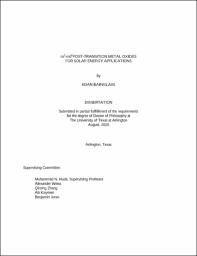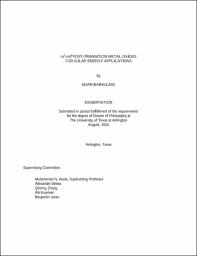
ATTENTION: The works hosted here are being migrated to a new repository that will consolidate resources, improve discoverability, and better show UTA's research impact on the global community. We will update authors as the migration progresses. Please see MavMatrix for more information.
Show simple item record
| dc.contributor.advisor | Huda, Muhammad N | |
| dc.creator | Bainglass, Edan | |
| dc.date.accessioned | 2021-08-06T14:05:40Z | |
| dc.date.available | 2021-08-06T14:05:40Z | |
| dc.date.created | 2020-08 | |
| dc.date.issued | 2020-08-10 | |
| dc.date.submitted | August 2020 | |
| dc.identifier.uri | http://hdl.handle.net/10106/29964 | |
| dc.description.abstract | Meeting the growing global energy demand while mitigating the deterioration of the global climate requires the rapid introduction of clean, renewable, and sustainable fuels. Solar energy output at daytime provides more than enough to satiate global demands. However, to utilize solar energy at night would require the development of efficient materials for solar energy storage. Photoelectrochemical (PEC) water-splitting is regarded as one of the most promising solar storage technologies. The material properties necessary to drive both O2 and H2 evolution reactions may be decoupled by designing a photoanode-photocathode PEC cell, with each half reaction respectively handled by an n-type and a p-type semiconductor. In this dissertation, the ns2-md0 metal oxide class is investigated computationally using density functional theory to determine its viability as a platform on which to design and develop the next generation of materials for solar energy applications. Metal oxides are stable, abundant, and environmentally safe. They are also highly flexible in their electronic properties. Many n-type metal oxides have been studied for PEC applications in attempt to improve their light absorption and conduction properties. In contrast, p-type metal oxides are rare due to the depth of the O 2p dominated valence band maxima (VBM) of metal oxides. The ns2-md0 class has been suggested as a mechanism for upshifting the VBM and improving hole carrier mobility via ns2 – O 2p hybridization. The first part of the dissertation aims to study the electronic structure of ns2-md0 systems in various crystal symmetries containing different n and m values. The second part studies the theoretically predicted novel quaternary metal oxide CuBiW2O8 (CBTO), which has recently been successfully synthesized and identified as a promising p-type solar absorber. Here, the introduction of Cu 3d orbitals in an ns2-md0 system further upshifts the VBM due to the height of Cu 3d energy levels relative to O 2p. However, localized Cu 3d orbitals also hinder efficient charge extraction. Anion doping in the form of S-in-O substitution is investigated as a means of reducing VBM localization. Lastly, CBTO surfaces are explored as an initial step in a larger study aimed to determine the effects of secondary phase impurities observed on the CBTO sample surface during the experimental synthesis. To estimate the relative stabilities of CBTO surfaces, an improved methodology is proposed to calculate surface energies addressing the inherent complexities of quaternary metal oxides. ["An updated version of this dissertation was re-submitted on 8/6/2021. The published versions of Chapter 4 and 6 and the appendix chapter have been added to the original version of the dissertation. The updated dissertation has been approved by the research advisor."] | |
| dc.format.mimetype | application/pdf | |
| dc.language.iso | en_US | |
| dc.subject | Density Functional Theory | |
| dc.subject | Photoelectrochemical Water-Splitting | |
| dc.subject | Solar Energy | |
| dc.subject | Metal Oxides | |
| dc.subject | Stibiotantalite | |
| dc.subject | Russellite | |
| dc.subject | CuBiW2O8 | |
| dc.subject | CBTO | |
| dc.title | ns2-md0 Post-Transition Metal Oxides for Solar Energy Applications | |
| dc.type | Thesis | |
| dc.degree.department | Physics | |
| dc.degree.name | Doctor of Philosophy in Physics and Applied Physics | |
| dc.date.updated | 2021-08-06T14:05:41Z | |
| thesis.degree.department | Physics | |
| thesis.degree.grantor | The University of Texas at Arlington | |
| thesis.degree.level | Doctoral | |
| thesis.degree.name | Doctor of Philosophy in Physics and Applied Physics | |
| dc.type.material | text | |
| dc.creator.orcid | 0000-0001-7218-0176 | |
Files in this item
- Name:
- BAINGLASS-DISSERTATION-2020.pdf
- Size:
- 3.750Mb
- Format:
- PDF
- Name:
- UPDATED-BAINGLASS-DISSERTATION ...
- Size:
- 5.015Mb
- Format:
- PDF
- Description:
- UPDATED-BAINGLASS-DISSERTATION ...
This item appears in the following Collection(s)
Show simple item record



